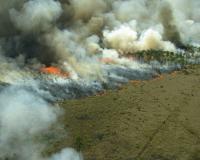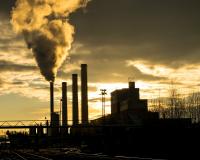
Vibrant Environment
Environmental Justice
All | Biodiversity | Climate Change and Sustainability | Environmental Justice | Governance and Rule of Law | Land Use and Natural Resources | Oceans and Coasts | Pollution Control

Last month, the New York Times reported that the Trump Administration began drafting a new rule that could eviscerate one of the most powerful tools available to U.S. citizens to hold the government accountable for environmental harm. The new rule, if finalized, would prevent concerned citizens from filing cases with the U.S. EPA Environmental Appeals Board (EAB), as well as inherently change EPA’s appeals process and undermine enforcement of environmental law throughout the country.

In the last two weeks, Indonesian islands Sumatra and Borneo began experiencing severe forest fires, evoking fears within the region that the fires could have similar effects to the fires of 2015, which was one of the worst years for transboundary haze in Southeast Asia. Following the 2015 fires, Indonesia took steps to limit the burning and draining of peatland to reduce the outbreak of fires in addition to improving environmental sustainability and air quality in the region. However, due to a combination of governance challenges and climate change-intensifying dry seasons, the country has struggled to keep up with implementing fire mitigating activities in all fire-prone areas.

In recent months, the long-standing environmental justice (EJ) movement—which began with the civil rights movement—has gained new momentum. EJ refers to the “fair treatment and meaningful involvement of all people regardless of race, color, national origin, or income with respect to the development, implementation, and enforcement of environmental laws, regulations, and policies.” As natural disasters ravage minority, low-income communities, global climate justice campaigns demand equitable solutions, and members of Congress underscore the importance of ensuring environmental protection for our most vulnerable communities, EJ principles are given a leading role in the conversation about environmental policy.

Much of the media concerning climate change have direly emphasized that its most horrendous effects will be borne by some of the world’s most impoverished developing cities, with coastal settlements on the front lines of this siege. Yet, most of these headline-grabbing pieces rarely explore the true complexity of these issues beyond mere sea-level rise and a few other similarly visible or tangible environmental problems. This blog aims to briefly outline the deeper extent of crises threatening these cities by further examining an experience of one particular city. A city where the ravages of global warming are more than just dire warnings—but a clear and present burden on its overwhelmingly underprivileged citizens every day. A city that offers perhaps one of the most holistic case studies to examine the entangled causality between environmental and social issues wrought by climate change. My hometown, Karachi, Pakistan.

In honor of the Environmental Law Institute’s 50th Anniversary Year, each month of 2019 highlights a different key theme that represents an important aspect of our work. July is focused on environmental justice, a movement and a concept that encompasses efforts to highlight the disproportionately harmful environmental impacts experienced by vulnerable communities, as well as a commitment to ensuring justice for all people. The growing effort to identify environmental justice concerns and to develop solutions for communities closely aligns with ELI’s mission to make law work for people, places, and the planet, including through our work in the Gulf of Mexico region.

The mission of California's Department of Toxic Substances Control (DTSC) is to "protect California's people and environment from harmful effects of toxic substances by restoring contaminated resources, enforcing hazardous waste laws, reducing hazardous waste generation, and encouraging the manufacture of chemically safer products." But, like any critical mission, its success depends on sufficient funding. And, to the detriment of the vulnerable communities it is charged with protecting, the Department is in the midst of dealing with a budget shortfall that will handicap its ability to reduce the amount of hazardous waste generated in California—hazardous waste that disproportionately impacts low-income and minority communities.

Throughout the month of July, ELI is taking a closer look at “Environmental Justice & Vulnerable Communities” as we continue to offer special events, programs, and publications in commemoration of our 50th Anniversary. As part of this month-long introspection into our work in environmental justice, Research Associate Lovinia Reynolds and Research and Publications Intern Anthony D’Souza reached out to Barry E. Hill, ELI Visiting Scholar and Adjunct Law Professor at Vermont Law School. Prior to coming to ELI, Professor Hill was the Senior Counsel for Environmental Governance at EPA’s Office of International and Tribal Affairs. From 1998 to 2007, he was Director of EPA’s Office of Environmental Justice. Below are Professor Hill’s thoughts and perspectives, as an environmental justice advocate, on environmental justice in the United States.

Climate change threatens to dramatically increase inequality and create greater hardships for women and girls, in large part because of their disproportionately vulnerable economic, social, and political positions worldwide. Food shortages disproportionately affect the health of women and girls, and in many regions, women are more directly dependent on natural resources threatened by climate change for their livelihoods. For instance, a U.N. report observed that in developing countries, women account for 45-80% of all food production, and about two-thirds of the female labor force is engaged in agricultural work. In such developing regions, women face unique vulnerabilities from the increasing unpredictability of food sources as well as the loss of income or jobs if agricultural resources are impacted by climate change.

When’s the last time you found yourself idly shopping out of boredom or buying a shirt just because it was on sale? If it was in the last week, then you’re not alone. The average American shopper buys 60% more clothing today than they did just 15 years ago, but keeps it for only half as long. At the end of the year, this results in approximately 80 pounds of unwanted clothing per person!

Several cases before the U.S. Supreme Court this term touched environmental law, ranging from jurisdictional disputes over a state’s right to ban uranium mining to whether state or federal laws apply when hunting moose from a hovercraft along an Alaskan river. An unusual amount of cases navigate the intersection of environmental regulations and tribal sovereignty, the Court so far siding with tribes on the issues of state fuel tax exemptions and hunting rights. One pending case, Carpenter v. Murphy, is not explicitly environmental, but the answer to its core question has potentially seismic environmental implications: is the eastern half of Oklahoma still, technically, an Indian reservation? While the case primarily involves criminal jurisdiction, the degree to which the Court accepts or rejects this question may alter taxation, regulation, and even ownership of one of the most energy resource-rich regions in the country.